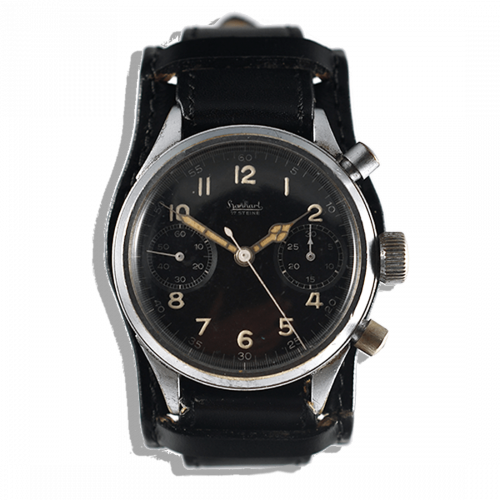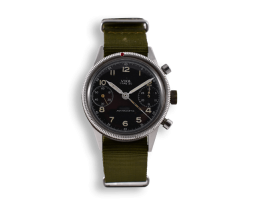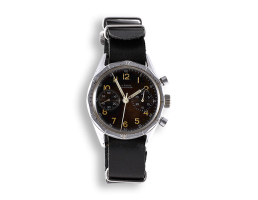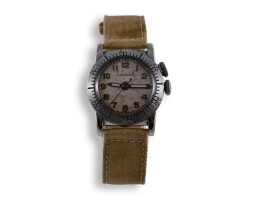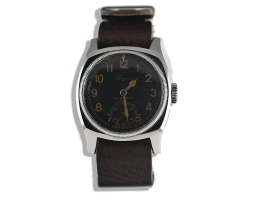- YEAR : 1954
- Ref. 5100-54
flieger chronograph me 109
Battle of Britain
| Brand | Hanhart |
| Model | Military watch |
| Version | Battle of Britain |
| Manufacturer reference | LH-41 |
| YEAR | 1940 |
| Type of movement | Mechanical movement with manual winding |
| Case material | Chrome metal |
| Strap material | Leather |
| Content delivered | Certificate of authenticity and travel case |
| Price |
5,200.00
Tax included
|
| Certificate | Certificate of authenticity |
| Mostra reference | MS0722393 |
Specifications
| New / Used | Pre-owned watch |
| Manufacturer's caliber reference | Calibre Hanardt 4054 with 17 jewels flyback |
| Case size (mm) | 41 |
| Lug (mm) | 20 |
| Type of glass | Mineral glass |
| Dial | Black with two counters |
| Buckle | Belt buckle tongue |
| Strap Type | Bund pilot bracelet |
| Min. strap length (cm) | 14 |
| Max. strap length (cm) | 26 |
| Strap color | Black |
| Specificities | Flyback watch, fixed pumps and assignment markings, 18,000 vph |
Hanardt pilot watch. A flyback chronograph calibre 41 type Battle of Britain me-109. This famous and rare military watch with a flyback function is the origin of most of the clocks used by military pilots of all nations during the second half of the twentieth century. To fully understand the innovative nature of this watch in 1940, we must place ourselves in the context of the time: It was designed around 1935-1936, and this watch was intended to be used in flight to allow aerial navigation between two points. The evolution of aviation is changing biplanes towards single-plane configurations that are much more difficult to fly and in which approach and navigation procedures must be more precise and faster. It will therefore be necessary to optimize the work of navigation to free the hands of the sailors to allow them to concentrate on the control of the machine, and sometime later during the civil war in Spain, on the complex manoeuvres which prevail during dogfights.
At the dawn of this war, one of the emblematic fighters of the Second World War was tested and developed: the Messerschmitt Me 109. This modern monoplane with single-engine and single-seat fighter required the pilot to be extreme awareness and to tend to many requests for checking flight parameters, all in a cramped cockpit in which nothing was superfluous. During its baptism of fire in 1937 during the Spanish Civil War, the pilots of the Condor Legion expressed the need to have a chronograph with a flyback function, as air forces and international brigades took their focus during aerial combat. Any distraction proves to be dangerous, even fatal, during modern air combat. Longines and hanardt will evolve their aviation watches towards so-called flyback models, with hanardt a version replacing the calibre 40 mono-pusher with a two-pusher flyback chronograph. Widely tested in the second half of the Spanish Civil War by German pilots enlisted alongside Franco's troops, this period will be crucial within the framework of this watch's preparations and development. They will finally be operational between 1939 and 1940 when pilots in the squadrons engaged in the offensives against the Axis in the Sudetes and Belgium or during the Battle of France would use them.
Like the Messerschmitt 109, this 41 mm watch format was surprisingly compact given its functions. The enveloping leather strap that accompanies it sheaths its case to protect the pushers from side impacts in the cockpit. Still, it is the leather strip which insulates it from the heat of the pilot's wrist, preventing it from fogging up during the rapid changes in altitude and temperature that these new fighter planes allowed. This feature will make it possible to obtain, despite these constraints, instant readability of the dials in flight and time parameters never seen before on a chronograph (a significant advantage for the pilot essentially due to the large size of the hands and the strong contrast of the 41 mm dial of the Flieger chronograph hanardt calibre 41). Longines,will remain for the military watches on a very readable version but without a chronograph with the Majetek model used by Czech pilots enlisted in the British Royal Air Force.
But it was during the Battle of Britain that the confrontation took on its whole dimension with, on the one hand, the aeroplane-watch duo: Spitfire - Longines (Weems or majeteck) provided in the Royal Air Force in opposition to the German fighter Me-109 with pilots equipped with the hanardt 41 mm chronograph. The flight manuals for both aircraft detailed the use of the watch during navigation operations (for calculating flight minutes), air fighter operations during combat (fuel management) and landing field approaches (moving away from the runway and entering the circuit). Fundamental elements of the lives of pilots that will influence the specifications of the victorious Allied armies after the war (for example, for France, the drafting of the specifications for the Breguet, Auricoste and Dodane type 20 and 21 pilot chronographs from 1954 and 1956 for the air force, which will even use the Vixa type 20 model, recovered as war damage, a chronograph watch adapted to the piloting of jets of the time from the hanardt 41 of which it will keep the same hanardt calibre 41 movements)
They were distributed in over fifteen nations (such as the Swiss Air Force, Spanish Air Force, and even the state of Israel, which will officially buy the Czechoslovak version of the Messerschmitt Bf 109 G-12 called S.199 during the war of independence in 1948). The Hanardt cal 41 chronographs will accompany these planes, the watch having left integral to the piloting of the aircraft in the aircraft flight manual. In terms of watchmaking mechanics, the Flieger chronograph is a watch with two pushers, a black dial with white inscriptions equipped with two totalizers (small seconds on the right over the 60s and thirty minutes indexed by minutes on the right. The chronometric functions control the central second hand on return to flight (Chrono start push-button from the top, reset, immediate return for instantaneous restarting of timing: lower pusher, timing stopped by upper pusher if Chrono running and reset to zero if chronograph stopped with the lower pusher) The hanardt calibre 41 movements is built based on the calibre 4054, a hand-wound 17-jewel mechanical movement that operates at 18,000 vibrations per hour and has a 42-hour power reserve after winding (22 with the chronograph running)
- vintage military pilot's chronograph.
- Black dial, Tritium-enhanced numerals and hands.
- Two totalizer counters with small seconds at 9 o'clock.
- Hanhardt flyback movement with manual mechanical winding.
- Hanhart Caliber 4054 at 18,000 vibrations per hour.
- White central seconds hand with flyback.
- Anti-magnetic housing in chromed metal
- Screwed caseback with aperture indentations.
- Assignment markings on the back of the case.
- Dial‚ case and movement marked.
- Sold with Mostra carrying case.
- Certificate of authenticity
- Glass case indexes and hands in perfect condition.
- Watch comes with a two-year warranty.
You might also like...
- YEAR : 1954
- Ref. J88.001
- YEAR : 1943
- Ref. A11-40
- Reserved
- YEAR : 1948
- Ref. 3582

